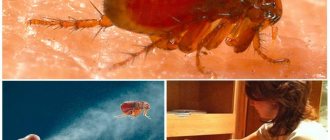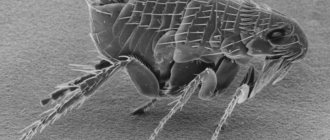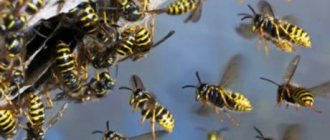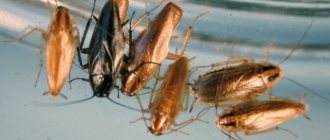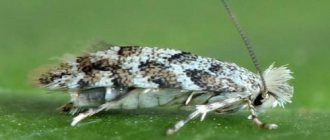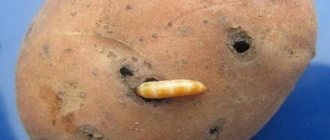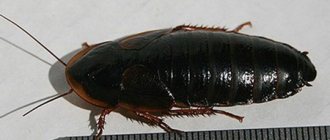Mallophagosis is the most common disease of poultry caused by pereaters (chicken lice). Parasitic infestation negatively affects weight gain and egg production, so it must be eliminated in a timely manner. Poultry owners are often interested in what methods exist to combat featherworm in chickens, how to treat the disease, and whether it is transmitted to humans. To eliminate parasites, both chemical and folk remedies are used.
Chicken feather eaters are microscopic parasitic insects that live in the feathers or layer under the feathers of birds.
Who are the Pereaters?
The cause may be mallophagosis, a parasitic infection. It is caused by feather eaters, almost invisible to the human eye; they are popularly called feather eaters or chicken lice.
Description of the insect
The beetle is a tiny parasite that looks like a yellow-brown louse. Slightly elongated body about 3 mm long and 0.3 mm wide.
On the lower part of the head there is a gnawing mouthparts. On the chest there are 6 legs with claws, with which the insect clings to the feathers and moves along them.
The insect feeds on feathers, down, and particles of dead epidermis.
It reproduces actively at plus 25-30 degrees and humidity of about 80 percent. The female attaches eggs to the feathers. After 14-20 days the process is repeated. An individual lays about 120 thousand eggs during its life.
Development from egg to adult is 3-4 weeks. During this time, there are 3 stages of molting.
An adult feather eater lives on the body of a bird for about a month, in the external environment - from 2 to 6 days.
Expert opinion
Firsov Sergey Arkadevich
Poultry farmer
There can be about 10 thousand chicken lice on a bird's body.
Impact of parasites
Infection of birds with feather eaters is a dangerous phenomenon. It causes irreparable harm to both old and young individuals.
- Sick chickens lay 10 percent fewer eggs than healthy ones, as the birds’ bodies weaken and cannot function normally.
- Immunity decreases, birds get sick more often.
- The growth of chickens slows down, puberty of young individuals occurs later than usual.
- Chickens eat little and gain weight poorly.
- Decorative breeds lose all their attractiveness: feathers fade and fall out, bare areas of skin appear.
- Birds do not tolerate climate change well, especially during cold periods.
- Chickens become restless and pull out the feathers of themselves and their relatives.
- Wounds appear on bare skin that do not heal well. They become infected and suppuration begins.
Down eaters are also dangerous for humans. A microscopic insect can become a carrier of infection, causing allergies and swelling.
Causes and routes of infection
All birds are susceptible to mellophagosis - downy feather eaters, but chickens are especially affected. Experts have found that young parasites move most actively.
Insects can be seen on the body of birds with the naked eye. They look like tiny brown sticks, sometimes the skin and feathers are strewn with them, which means mellophagosis has started.
Expert opinion
Firsov Sergey Arkadevich
Poultry farmer
A distinctive feature of periodons is their ability to adapt to almost any conditions. Even if there is no bird and nothing to eat, they are able to survive. Poultry farmers find them on the walls of chicken coops, perches, bedding, in nests, and feeders.
Chickens can become infected with parasites from each other, through food, sitting in the nest and on a perch, or bathing in dust on the street. Closed chicken coops do not protect against mellophagosis. If one bird gets sick, the rest will become infected within a short time.
The parasitic lesion spreads quickly if:
- In an enclosed space where chickens are kept, there is warm and humid air;
- The straw bedding on the floor and in the nests is changed irregularly;
- Many birds are kept in a small chicken coop;
- When domestic birds are outside, wild birds fly to them: magpies, pigeons, crows and others. They are the main carriers of fluff eaters;
- Often parasites are brought in by people who carry lice eaters on dirty soles, clothes, and equipment into the chicken coop.
Harm and danger
If we talk about the dangers of this mite for the health of chickens, then it can cause the main damage to the productivity of these birds. Under the influence of feather eaters, the chicken’s body is greatly weakened and is unable to function normally. The egg production of birds decreases by an average of 10%. Chickens grow much slower than usual, while their sexual development is greatly slowed down and maturity occurs much later.
Decorative breeds suffer primarily aesthetically, since the structure of the plumage is disrupted and baldness appears. Affected feathers become dull.
Find out how to get rid of worms in chickens.
Unprotected areas of skin appear on the chicken's body, which are easily affected by infections. The skin becomes covered with wounds in which dirt accumulates and creates a favorable environment for the proliferation of microorganisms. As a result, in addition to being affected by the bird eater, the laying hen begins to suffer from other, no less dangerous, diseases.
How to deal with beetles
Having sensed the parasite, the birds try to cure themselves. But no matter how hard they try, it is impossible to rid chickens of ticks without human intervention.
It is necessary to begin the fight against beetles from the moment the first signs of their appearance in the chicken coop are detected. The infected individual must be immediately removed from the rest, and healthy chickens must be treated with insecticides. The poultry house is thoroughly cleaned and disinfected; in addition, surfaces can be treated with a blowtorch or steam.
In parallel with preventive work among healthy livestock, therapeutic measures are carried out for sick birds. In order to get rid of parasites, chemicals or folk remedies are often used.
Did you know? Period is dangerous not only for birds, but also for people. This tick can be a carrier of typhus or salmonellosis, and can also cause allergies. Its bites cause severe itching, which can lead to swelling.
Chemicals
Using chemical repellents is a very effective method. In every veterinary pharmacy you can find a lot of remedies for parasites. These poisons affect the nervous system of pests, which leads to their rapid death, without affecting the body of birds.
To make the use of drugs more effective, the following rules must be followed:
- Preparations in the form of drops should be applied to the withers so that the chicken cannot reach the feathers and get poisoned. Ticks die in a couple of minutes, so tying the beak can be another way to protect the chicken.
- Sprays are sprayed at a distance of 15 cm. You can protect the bird’s eyes from getting the medicine by covering its head with a cloth.
- The action of all drugs is aimed at destroying adult insects, but does not affect their eggs. In this regard, the procedure for destroying ticks must be repeated after 7–10 days. If you ignore it, then after two weeks the chicken will again suffer from parasites.
Important! Chemical preparations are too toxic and are not suitable for chickens, so for their fragile bodies it is worth choosing more gentle means.
Insecticides
As for such drugs, store shelves are now full of various products, but the most popular and accessible are the following:
- Nyuda is a human preparation in the form of a spray for removing lice. It has an equally effective effect on birds. Its price is quite high, and therefore it is most often used for processing small numbers of livestock.
- “Butox” is good at removing various types of insects. Produced in the form of ampoules. The product should be diluted in a ratio of 1 ml of medication per 1.5 liters of water. It is applied to feathers by spraying and is also used to treat poultry houses.
- "Frontline" is sold in both drop and spray form. Only harms adult ticks. Subsequent treatment is carried out a week later.
- “Insectol” - with this product, the chicken is treated with areas under the tail and wings, spraying the medication in an amount of 0.4 ml until the feathers are slightly moistened.
- “Arpalit” is a ready-made spray for complete treatment of poultry, which will protect the laying hen from further infection.
Disinfectants
Disinfection of birds is mandatory when feather eaters appear. Conventional means will not help to exterminate ticks; the desired effect can only be achieved thanks to those drugs that react in combination with water:
- “Butox” is an ampoule preparation against ticks and other parasitic insects. To treat one chicken, you will need one ampoule. The drug penetrates the skin and is eliminated from the body through the digestive system, which produces a complex effect on a number of parasites. Diluted with water in a 1:1 ratio.
- "Entomozan" - used for processing chickens. Before the procedure, collect all the eggs in the chicken coop, and then irrigate the birds with a solution of the drug and water (5 ml of Entomozan per 1 liter of water). Repeated treatment is carried out after 9 days.
- "Neostomozan" - the drug is used in the form of an emulsion. It is formed as a result of the reaction of medication and water. For chickens, it will be enough to mix 1.5 ml of solution with 10 liters of water. The liquid is poured into a spray bottle and sprayed on the bird.
- “Tsifox” - this drug is used to treat specific areas where ticks accumulate. The solution is prepared at the rate of 10 ml of the drug per 5 liters of water. After 12 hours from the time of treatment, the drug should be washed off with a damp cloth and soapy water.
Repellents
There are also a number of drugs that have a repellent rather than lethal effect on parasites. This is a fairly effective prevention for healthy chickens, especially if there is already an infected individual in the population. The most used drugs to eliminate the disease are the following:
- "Frontline" is used as a drug against ticks in dogs, but is also suitable for poultry. Quite an effective product and at the same time non-toxic. The drug is applied to the withers. Its effect lasts for several weeks.
- “Leopard” is used to destroy various types of parasites not only in animals, but also in birds. The product should be applied with a pipette to the bird’s neck, the recommended dose is 1.4 ml. This product is also used to treat roosts against pests by spraying medication.
- "Vitomax" - comes in the form of a spray, has a low cost. It is better to spray the product starting from the tail at a distance of 30 cm until the plumage is slightly moistened. The spray should penetrate the skin, but be careful not to let it get into your eyes.
Folk remedies
The abundance of chemicals allows you to quickly get rid of the periodontal beetle, although you can refuse them, since the pest can be removed using more environmentally friendly, and most importantly, cheaper, means.
Herbs
In our fields and gardens there are many different kinds of herbs that can save the chicken coop from feather eaters. The most repellent plants for these ticks are wormwood, chamomile, tansy and wild rosemary. All these herbs are dried and ground, after which the powder is scattered on the litter. This will serve as an excellent preventative against chicken fleas.
Another way to get rid of ticks is powder made from blackberry and hellebore branches. This mixture is sprinkled on the bird, which helps an already infected chicken get rid of parasites. But this product carries some danger for weakened chickens; in this case, you need to dilute the product with water (2 g per 0.5 l).
Decoctions and infusions
Herbal decoctions can be treated no less effectively than medications.
For example, chamomile infusion is brewed like strong tea, and this remedy is rubbed into the affected areas of the skin for a week. You can also use this method to eliminate illness in chickens.
It is also recommended to brew a solution of tansy and wormwood, which is then used to wash shelves, walls, feeders and drinkers in the poultry house. To do this, you need to brew one of the plants in boiling water in a 1:1 ratio and let it brew overnight.
Ash
Ash has proven itself very good in the fight against chicken fleas. Its mixture with sand removes parasites very quickly.
In order to prepare this remedy, you will need ash and sand in equal proportions. These ingredients are mixed and placed in a container that is installed at the entrance to the chicken coop. It is better to have several such baths, then it will be easier for laying hens to bathe without interfering with each other.
Insects cannot tolerate such procedures and die or run away.
You can also make some kind of cream from the ash by adding vinegar or kerosene to it. This medicine is applied to the chicken and left until the effect occurs. The air supply to the parasites is blocked and they die. But this procedure can only be done with adult chickens.
Symptoms of appearance
Mallophagosis can be detected by paying attention to the behavior of chickens. The appearance of parasites will make itself felt with a number of symptoms that are not typical for other diseases.
- Birds are constantly running around, their behavior is restless.
- They eat little or refuse food altogether.
- The plumage is often cleaned.
- They peck themselves, pulling out fluff and feathers.
- Chicks grow more slowly and adults lose weight.
- They began to rush less.
Further the picture gets worse. New signs appear:
- Feathers with the shaft eaten away begin to fall out. Chickens begin to pull out feathers not only from themselves, but also from each other.
- Bare, often inflamed areas of skin appear. Scratching areas are especially visible around the neck, on the tail, and on the inside of the wings.
- The mucous membrane of the eyes becomes inflamed and suppuration appears.
Expert opinion
Firsov Sergey Arkadevich
Poultry farmer
If treatment for mallophagosis is not started on time, the bird will die.
How to remove fluff eaters
Getting rid of the parasite can be very difficult. The period for eliminating parasites can be a month, and sometimes 6 months. The fight against periodontal beetles should begin at the same moment when the presence of the disease was detected. It is easier to cope with mallophagosis with timely initiation and adequate treatment. Today there are two effective methods of treatment for parasites - chemical and folk.
Chemicals
Treatment of the disease is considered more effective if it is dealt with using chemical methods. Ready-made preparations for external use, which are used in veterinary hospitals, have an effect on the adult fluff eater, affecting its nervous system and thereby provoking the death of the parasite. Note that for poultry, drugs aimed at combating lice eaters do not pose any danger. How to properly treat chickens is described in the instructions included with the medications.
Veterinarians note the particular effectiveness of treatment using drops of “Bars”, “Stronghold”, “Frontline”, “Neotomazan” and some other chemicals intended for the treatment of pets. Let us add that to treat the chicken coop in order to get rid of lice-eaters temporarily located on the walls and floor of the building, a liquid called “Karbofos” is used. If the flock is small, products that are used to treat lice that appear in humans, for example, Nyuda spray (the packaging of the drug is in the photo), will help get rid of parasites in chickens. However, a number of the drugs mentioned do not act on larvae deposited by parasites.
To destroy young fluff eaters that emerge from laid eggs after 7-10 days, additional treatment is carried out. The treatment will be effective if spraying is carried out thoroughly, so that the entire skin of the animal is disinfected. It is important to know that when sprays are used, parasites try to move to the bird’s neck area. In addition to treatment with chemicals, as experts advise, during treatment, ash-sand baths should be installed for dry bathing of birds, adding insecticides to the mixture of sand and ash.
Folk remedies
Kerosene will be effective in fighting beetles. This product instantly kills not only adult lice beetles, but also partially destroys the chitinous shell covering them. Kerosene can be used to treat chickens by mixing it with water and vinegar. This liquid should be used to treat the bird's feathers.
Also, a mixture of ammonia, benzene and kerosene is used to treat the chicken coop and animals. Even the smell of this mixture repels parasites. Chamomile flowers, tansy and rosemary branches, the smell of which can scare them away, have long been considered remedies against such parasites.
Prevention
The list of recommended preventive measures is as follows:
- treating the room where chickens live with boiling water or steam;
- timely removal of old dirty food and droppings;
- constant change of chicken coop litter;
- excluding contact between chickens and wild birds.
We also recommend installing sand baths mixed with ash. Do not forget to periodically inspect the roots of the down and feathers of chickens for symptoms of damage and monitor the behavior of the birds. We strongly recommend that you take great care to keep your clothes and shoes clean when caring for your bird.
How to get rid of lice eaters in a chicken coop
If poultry farmers find down feather eaters on the body of chickens, it is necessary to urgently begin work to remove the parasites. This process is a set of measures to kill insects and prevent the spread of the disease.
The more birds affected by the mite, the longer it will take to remove it. Often one treatment is not enough, chicken lice appear again. Therefore, it is necessary to carry out procedures methodically and patiently until mallophagosis is completely eliminated. This usually takes from 3 to 6 months.
To make the work quick and effective, experts recommend using synthetic drugs in combination with folk remedies. The former destroy parasites, the latter repel them and are an excellent disease prevention.
How to deal with beetles
When chickens feel mites on their bodies, they begin to treat themselves. But without active human intervention this is impossible.
Birds showing signs of disease should be separated from the rest and treated with chemicals designed to kill parasites.
Expert opinion
Firsov Sergey Arkadevich
Poultry farmer
At the same time, carry out prevention using folk remedies or insecticides among healthy chickens.
The chicken coop must be cleaned, disinfected, and litter and nests destroyed.
Chemicals for killing beetles
The use of insecticides is an effective measure to combat parasites. The drugs destroy the nervous system of insects, destroying them. But the products must be used taking precautions so as not to harm the birds.
- Drops are applied to the back, treating the entire feather cover so that chicken lice cannot crawl to uninfected areas.
- Powdered products are rubbed into the feathers, thus treating the entire body of the bird.
- The spray is sprayed from a distance of approximately 20 cm, without missing a single area. To prevent the aerosol from getting into the chicken's eyes, cover its head with a cloth. Please note that the spray cannot be used to treat chickens less than 3 months old.
After treatment, the birds experience severe itching, so they begin to peck at themselves. To prevent this from happening, you should tie the beak.
Depending on their effectiveness, the drugs destroy adult insects and larvae within a few minutes. Chemicals do not affect eggs, so you need to re-treat them after 7-10 days.
By this time, new lice eaters will hatch from the eggs, which must be destroyed. Otherwise, after a couple of weeks, the chickens will again become infected with mallophagosis. Experienced poultry farmers advise re-processing birds after 9 days in summer, and after 12 in winter.
The basic rule for killing parasites is to strictly follow the instructions that accompany the insecticide.
During processing, you must take care of protective equipment so as not to harm your health:
- use gloves and a mask or respirator;
- clothing must cover the entire body, hair must be removed;
- after work, disinfect clothes and shoes without bringing them into the house;
- take a shower and rinse your eyes well.
Insecticides
In veterinary pharmacies and specialized stores you can purchase various products that successfully deal with chicken lice.
The most popular and effective are the following:
- "Butox." Destroys different types of parasites. Available in ampoules. Before use, you need to dilute it in a ratio of 1 ml per one and a half liters of water. Pour into a spray bottle and treat the birds' feathers. Can be used to disinfect the chicken coop.
- "Arpalit". Spray for treating birds against various types of parasites, has a long-term effect and prevents re-infection. Can also be used for chickens from 2 months.
- "Frontline". It is produced in 2 forms: drops and spray. Destroys adult lice beetles. Repeated treatment is recommended after a week.
- "Nude." The drug is used to remove head lice in humans, but is also effective for birds. In addition, it is slightly toxic. It is usually used for isolated cases or for treating expensive ornamental breeds, since the cost of the drug starts from 500 rubles.
- "Insectal." Available in spray form. The main component is neopinamine, which has proven itself as a drug that has a detrimental effect on various insects.
Most of these drugs are intended to remove parasites from cats and dogs, but they are also used to kill fluff eaters. Drops are used if the infection is not widespread, and sprays are used if many birds need to be treated.
Disinfectants
Disinfectants are intended for the treatment of premises. They contain antimicrobial substances, are highly soluble in water, safe, and do not have an unpleasant odor.
Sometimes chemicals do not help when processing poultry. Then products are used whose effectiveness is achieved in combination with water.
- "Entomozan". Produced in ampoules. Diluted in the ratio: 5 ml per 1 liter of water. The chickens are locked in the poultry house, having first collected the eggs. The hens are then irrigated, for example using a garden sprayer. The next treatment is after 9 days.
- "Cifox." A preparation for spot treatment of places where parasites accumulate. Mix 10 ml per 5 liters of water, disinfect areas, rinse with soap and water after 12 hours.
- "Butox." Available in ampoules. To treat 1 chicken, 1 dose is required. Dilute with water in a one to one ratio.
- "Neostomozan." Emulsion product. Dissolve 1.5 ml of disinfectant in 10 liters of water, pour into a sprayer, and treat the birds.
Repellents
To prevent mallophagosis, agents are often used that do not destroy parasites, but repel them. If an infected chicken is found in the poultry house, the following drugs are used:
- “Leopard”: 1.4 ml of the product is applied to the bird’s neck (you can use a pipette);
- "Frontline": drop on the neck, effective for several weeks;
- “Vitomax”: spray the spray from the tail, lifting the feather, until slightly damp.
Birch tar
An environmentally friendly and therefore safe drug is sold in pharmacies. It is made from birch bark from young trees.
Expert opinion
Firsov Sergey Arkadevich
Poultry farmer
Apply the product to the affected areas of the bird's skin. After the first application, the number of parasites decreases because they cannot stand the resinous smell. The drug has antiseptic and healing properties, so skin wounds heal quickly.
Folk remedies
To prevent and treat mallophagosis, it is not always possible to use chemicals.
And for the treatment of young hens and chicks, the use of insecticides is unacceptable. The best solution is to combine them with folk remedies.
Herbs
It’s worth looking around, and you can find herbs that will save the poultry house from the downy feather eater. For centuries, wormwood, wild rosemary, tansy, chamomile, and juniper have been considered the most effective. The grass is dried, ground and scattered on bedding and in the nests of laying hens.
If you sprinkle a mixture of crushed barnyard grass and wild cherry branches on a bird, this will rid it of insects . To treat weakened chickens, dilute the powder with water in the ratio: 2 grams per half liter of water.
Decoctions and infusions
Decoctions and infusions of wild herbs are successfully used in personal backyards. Infusions of chamomile, tansy, and wormwood are especially popular.
- Chamomile infusion. Pour 4 tablespoons of flowers into 1 liter of water, cook for 5 minutes. on low heat. Cool, strain. Rub into the feathers of hens and chicks.
- A tincture of tansy or wormwood is prepared in the same way: brew the herb in boiling water in one to one proportions and leave overnight. Treat the surfaces in the chicken coop with this solution.
Ash
Expert opinion
Firsov Sergey Arkadevich
Poultry farmer
In the chicken coop or poultry yard, troughs and/or other containers are placed into which ash and sand are combined in equal quantities.
To enhance the effect, add Chlorophos (2 percent of the volume of the mixture). When chickens bathe in troughs, they shake off insects.
Kerosene
- Kerosene (1 part), vinegar (4 parts), water (8 parts) are mixed and rubbed into the skin of the chickens. Several treatments may be required.
- Mix kerosene, ammonia, benzene in equal parts and treat the skin of the birds.
Only adults can be treated.
Treatment of the poultry house with iodine monochloride
To get rid of fluff eaters and avoid their appearance, it is necessary to disinfect the chicken coop. Iodine monochloride is well suited for this.
Place 10 grams of crushed aluminum and 200 ml of hydrochloric acid solution in a glass or ceramic container. The reaction will produce purple smoke that kills insects.
In addition to this method of processing the poultry house, others are used.
- Slaked lime. You need to whitewash the walls with it and spray the bedding. The product dries surfaces, eliminating favorable conditions for the beetle to reproduce. When everything is dry, the chickens are returned to the poultry house.
- A combination of chlorine and turpentine in a ratio of 4*1. The gases released during the reaction kill pests. The treatment should be carried out over a period of days in a well-ventilated area.
- Bleaching powder. Combine water and bleach and let sit for 24 hours. In the first 6 hours, it is necessary to periodically stir the solution. Leave in a closed poultry house. The released chlorine disinfects the room. After a day, ventilate the chicken coop well, and you can release the birds.
- Birch tar. Used for fumigation of poultry houses.
If the room is small (less than 50 sq.m.), you will need 100 ml of birch tar.
Mix it with dry sawdust (800 ml), they should be soaked for 1 hour.
Pour charcoal into a 5-liter basin (you can buy it from a store). The coal is burned until it slowly smolders.
Transfer the chickens from the poultry house to another place. Place the basin in the chicken coop, put sawdust soaked in birch tar on the coals.
When the smoke comes out, close the door.
After about 5 hours, ventilate the room so that there is no smell of smoke.
Among the chemicals used for disinfecting premises, “Virocid” and “Glutex” are used.
How to deal with feather eating in chickens
The problem is quite serious, since it requires immediate action, otherwise the parasites will take over the entire chicken coop and then it is unlikely that it will be possible to save the juveniles and adult birds. Treatment of this disease will require enormous patience from the owners, since it can take a lot of time - up to six months.
Experts recommend using an integrated approach, including both chemicals and folk remedies. Insecticides are very effective, and folk remedies are more suitable as prevention.
Drugs used
Both sick and healthy individuals will have to be treated with chemicals; in addition, the chicken coop must be disinfected.
All necessary medications are sold in veterinary pharmacies, and the seller can recommend the most effective remedy, depending on the degree of infection. To get rid of mallophage, it is permissible to use such toxic substances as:
- Frontline.
- Stronghold.
- Celandine.
- Insectol.
- Arnalite.
How the drugs are used:
- The beak of the poultry must be tied, after which the back or other areas are treated with one of the selected preparations.
- The spray is applied to the bird’s body from a distance of 15-20 cm.
- After a week, the treatment is repeated, since the substance does not affect egg laying. Before this period, it is not recommended to re-process chickens, as they may die.
- The fight against feather eaters in chickens has its own characteristics, for example, you cannot use sprays.
- You need to spray the product on all feathers, not just on the affected areas.
- The maximum effect can be obtained in combination if you use not only toxic substances, but also folk remedies.
You can disinfect the chicken coop with the following compounds:
- Cucaracha.
- Executioner.
- Tetrix.
- Battalion commander
- Dichlorvos.
In addition to the above drugs, it is permissible to use anti-flea drugs to combat cockroaches, bedbugs, ants, etc. The compositions are selected depending on the degree of infestation of the chicken coop. Often, agents with a very high degree of toxicity are required.
How to use the products correctly:
- Firstly, it is necessary to remember that the products are poisonous, so it is necessary to use personal protective equipment.
- Secondly, you need to carefully read the instructions and prepare the active composition strictly according to the instructions. The drug concentrations indicated on the packaging of each drug are based on processing conditions.
- All equipment that is intended for the life of chickens must be removed from the chicken coop.
- The litter is also removed, which is better to be burned.
- The working solution is applied to all surfaces. If a spray or aerosol is used, then you need to spray the product carefully.
- The best option is to prepare a solution from an emulsion concentrate. If you use sprays or aerosols, the consumption will be too high, which will increase the cost of treating the room.
- After treatment, all doors and openings should be tightly closed so that the substance can be absorbed into the base.
- After some time specified in the instructions, the room is ventilated.
Folk remedies
There are a number of simple and affordable ways to get rid of periodons. For example:
- Baths made of sand and wood ash . Chickens love to take dust baths, so you can help them and instead of dust prepare a special composition based on sand and wood ash. To do this, take a trough and pour sand and ash into it, after which these components are mixed. When chickens begin to bathe in this dry mixture, the feather eaters suffocate and die.
- Medicinal plants . If you take 4 tbsp. spoons of dry chamomile inflorescences and infuse in 1 liter of water, boiling the composition for about 5 minutes, this helps get rid of “chicken lice”. Instead of chamomile, you can take wormwood and prepare the remedy in the same way. After this, when the composition has cooled, it is rubbed into the feathers and skin of poultry.
Down eater. Prevention and treatment in laying hens.
Prevention measures
In order to protect chickens from mallophagosis, and not waste energy, nerves and money on destroying chicken feeders, it is better to carry out preventive measures in a timely manner:
- regularly clean the chicken coop from dirt and waste;
- systematically change the bedding and nest fillings;
- disinfect the poultry house once a month;
- closely monitor changes in the behavior of chickens;
- avoid contact between domestic birds and wild birds;
- make sure there is enough space in the chicken coop;
- promptly isolate infected individuals.
You can keep chickens healthy and protect them from death if you keep the poultry house clean.
Read our article on how to identify and treat spirochetosis in chickens and other poultry.
Preventive measures against ticks
Having successfully cured the entire population of chickens from fluff eaters, in order to prevent such a scourge in the future, you should take care of high-quality prevention of the disease. To a large extent, it lies in the normalization of sanitary and hygienic conditions for keeping poultry.
In this regard, special attention is paid to the following points:
- maintaining dryness in the poultry house;
- ensuring high-quality supply and exhaust ventilation;
- eliminating drafts in the room;
- regular removal of manure and dirt, in which mites can live for a long time;
- ensuring a sufficient amount of free space for each individual;
- timely replacement of contaminated litter with new one;
- the use of special feeders in the poultry house that prevent dirt and parasite eggs from getting inside;
- limiting contact between chickens and wild birds and rodents;
- timely detection and treatment of individuals infected with lice beetles;
- hanging brooms of dried chamomile or tansy in the chicken coop, which is also mixed with the litter.
Another extremely important preventive measure in the fight against parasites is regular disinfection of the chicken coop with special solutions. In this regard, lime, iodine monochloride, and waste material are used, which are mixed with creolin in equal proportions. Among the effective chemical preparations, “Virocid” and “Glutex” are often used. Treatment of premises, structural elements and perches is carried out at least once a month.
Lick eaters are small parasitic insects that live on the surface of the skin of chickens and feed on its particles, as well as the down and feathers of the bird. These pests are dangerous because they multiply extremely quickly and spread to the entire poultry population in a matter of days. Moreover, a serious infection with lice beetles is fraught with weakened immunity, a decrease in weight and egg production, and even the death of a laying hen. Therefore, therapeutic measures must be applied immediately upon identifying the first signs of trouble.
